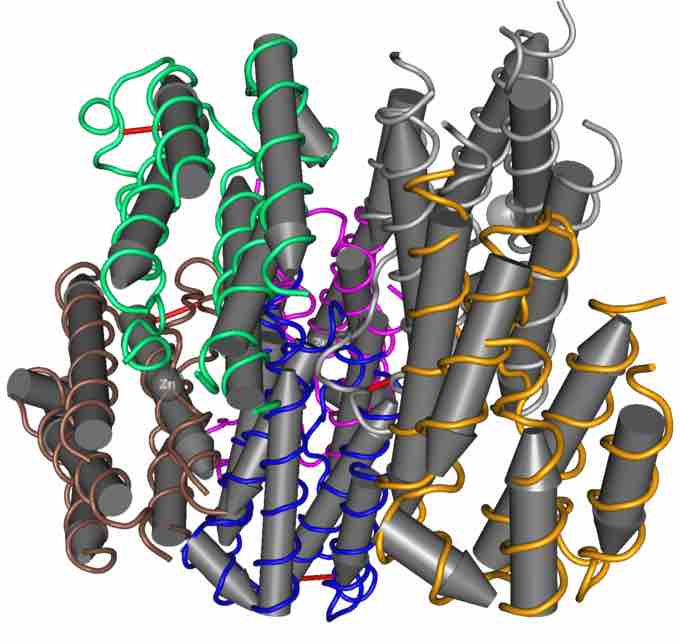Interferons (IFNs) are proteins made and released by host cells in response to the presence of pathogens such as viruses, bacteria, parasites, or tumor cells. IFNs belong to the large class of glycoproteins known as cytokines . Interferons are named after their ability to "interfere" with viral replication within host cells. IFNs have other functions: they activate immune cells, such as natural killer cells and macrophages, they increase recognition of infection or tumor cells by up-regulating antigen presentation to T lymphocytes, and they increase the ability of uninfected host cells to resist new infection by virus. Certain symptoms, such as aching muscles and fever, are related to the production of IFNs during infection.

Interferon
The molecular structure of human interferon-alpha.
About ten distinct IFNs have been identified in mammals; seven of these have been described for humans. They are typically divided among three IFN classes: type I IFN, type II IFN, and type III IFN. IFNs belonging to all IFN classes are very important for fighting viral infections.
Based on the type of receptor through which they signal, human interferons have been classified into three major types:
- Interferon type I: All type I IFNs bind to a specific cell surface receptor complex, known as the IFN-α receptor (IFNAR) that consists of IFNAR1 and IFNAR2 chains. The type I interferons present in humans are IFN-α, IFN-β and IFN-ω.
- Interferon type II: These bind to IFNGR that consist of IFNGR1 and IFNGR2 chains. In humans this is IFN-γ.
- Interferon type III: These signal through a receptor complex consisting of IL10R2 (also called CRF2-4) and IFNLR1 (also called CRF2-12). Acceptance of this classification is less universal than that of type I and type II, and unlike the other two, it is not currently included in Medical Subject Headings.
Effects of Interferons
All interferons share several common effects; they are antiviral agents and can fight tumors. As an infected cell dies from a cytolytic virus, viral particles are released that can infect nearby cells. In addition, interferons induce production of hundreds of other proteins—known collectively as interferon-stimulated genes (ISGs)—that have roles in combating viruses. They also limit viral spread by increasing p53 activity, which kills virus-infected cells by promoting apoptosis. The effect of IFN on p53 is also linked to its protective role against certain cancers. Another function of interferons is to upregulate major histocompatibility complex molecules, MHC I and MHC II, and increase immunoproteasome activity. Interferons, such as interferon gamma, directly activate other immune cells, such as macrophages and natural killer cells. Interferons can inflame the tongue and cause dysfunction in taste bud cells, restructuring or killing taste buds entirely.
By interacting with their specific receptors, IFNs activate signal transducer and activator of transcription (STAT) complexes. STATs are a family of transcription factors that regulate the expression of certain immune system genes. Some STATs are activated by both type I and type II IFNs. However, each IFN type can also activate unique STATs.
STAT activation initiates the most well-defined cell signaling pathway for all IFNs, the classical Janus kinase-STAT (JAK-STAT) signaling pathway. In this pathway, JAKs associate with IFN receptors and, following receptor engagement with IFN, phosphorylate both STAT1 and STAT2. As a result, an IFN-stimulated gene factor 3 (ISGF3) complex forms—this contains STAT1, STAT2 and a third transcription factor called IRF9—and moves into the cell nucleus. Inside the nucleus, the ISGF3 complex binds to specific nucleotide sequences called IFN-stimulated response elements (ISREs) in the promoters of certain genes, known as IFN stimulated genes ISGs. Binding of ISGF3 and other transcriptional complexes activated by IFN signaling to these specific regulatory elements induces transcription of those genes. Interferome is a curated online database of ISGs (www.interferome.org). Additionally, STAT homodimers or heterodimers form from different combinations of STAT-1, -3, -4, -5, or -6 during IFN signaling; these dimers initiate gene transcription by binding to IFN-activated site (GAS) elements in gene promoters. Type I IFNs can induce expression of genes with either ISRE or GAS elements, but gene induction by type II IFN can occur only in the presence of a GAS element.
In addition to the JAK-STAT pathway, IFNs can activate several other signaling cascades. Both type I and type II IFNs activate a member of the CRK family of adaptor proteins called CRKL, a nuclear adaptor for STAT5 that also regulates signaling through the C3G/Rap1 pathway. Type I IFNs further activate p38 mitogen-activated protein kinase (MAP kinase) to induce gene transcription. Antiviral and antiproliferative effects specific to type I IFNs result from p38 MAP kinase signaling. The phosphatidylinositol 3-kinase (PI3K) signaling pathway is also regulated by both type I and type II IFNs. PI3K activates P70-S6 Kinase 1, an enzyme that increases protein synthesis and cell proliferation; phosphorylates of ribosomal protein s6, which is involved in protein synthesis; and phosphorylates a translational repressor protein called eukaryotic translation-initiation factor 4E-binding protein 1 (EIF4EBP1) in order to deactivate it.